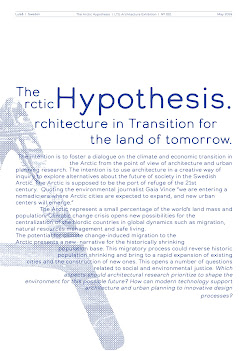The exhibition aimed to promote dialogue on climate and economic transition in the Arctic from an architectural and urban planning perspective, as well as to use architecture creatively to explore future alternatives for society in the Swedish Arctic.
The Arctic is expected to be the 21st century's refuge. To quote environmental journalist Gaia Vince, "we are entering a nomadic era where Arctic cities are expected to expand, and new urban centers will emerge." The Arctic represents a small portion of the world's landmass and population. The climate change crisis opens up new opportunities for the centralization of the Nordic countries in global dynamics such as migration, natural resource management, and secure housing. The potential for climate change-induced migration to the Arctic presents a new narrative for the historically shrinking population base. This migration process can reverse historical population decline and lead to rapid expansion of existing cities and the construction of new ones. This raises a range of questions related to social and environmental justice. What aspects should architectural research prioritize to shape the environment for this possible future? How can modern technology support architecture and urban planning for innovative design processes?
The Arctic is expected to be the 21st century's refuge. To quote environmental journalist Gaia Vince, "we are entering a nomadic era where Arctic cities are expected to expand, and new urban centers will emerge." The Arctic represents a small portion of the world's landmass and population. The climate change crisis opens up new opportunities for the centralization of the Nordic countries in global dynamics such as migration, natural resource management, and secure housing. The potential for climate change-induced migration to the Arctic presents a new narrative for the historically shrinking population base. This migration process can reverse historical population decline and lead to rapid expansion of existing cities and the construction of new ones. This raises a range of questions related to social and environmental justice. What aspects should architectural research prioritize to shape the environment for this possible future? How can modern technology support architecture and urban planning for innovative design processes?
The exhibition was based on three hypotheses:
Form follows environment. This hypothesis suggested that the design of future Arctic settlements would be directly influenced by Arctic environmental conditions, adapting the form to wind, snow, ice, rain, and changing landscapes.
The network works. This concept viewed the city as an interconnected system where local issues and broader territorial challenges mutually influence each other, integrating local communities into larger regional or global discussions.
Green, blue, and white. Towards sustainability, this approach treated nature as essential infrastructure for the northern regions, with design strategies that effectively utilized vegetation, water, and ice as interconnected systems.
The exhibition aimed to engage both practical and theoretical perspectives and positioned architecture as a crucial perspective for exploring and understanding the current changes in the Arctic. By integrating this interdisciplinary approach into university research and teaching, it underscored the importance of combining creative and analytical methods to visualize sustainable future perspectives for this rapidly changing region.


